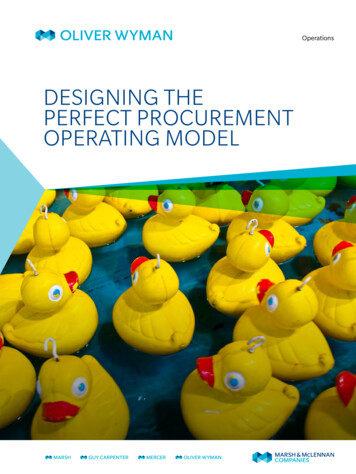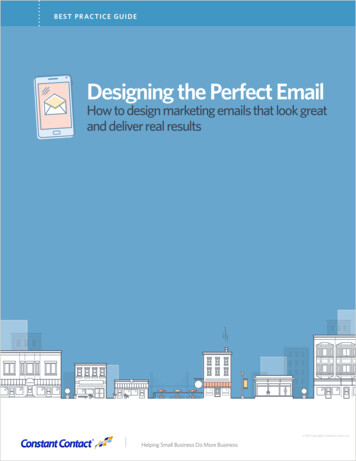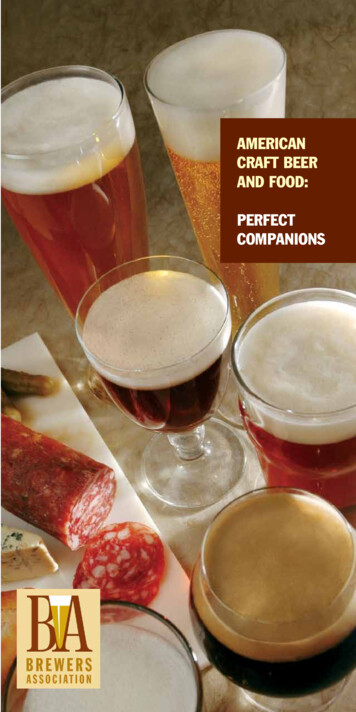
Transcription
OperationsDESIGNING THEPERFECT PROCUREMENTOPERATING MODEL
DESIGNING THE PERFECT PROCUREMENTOPERATING MODELWhen it comes to defining the most efficient and effective operating model for procurementfunctions there are, unfortunately, no easy answers.The operating model of a procurement function needs to be consistent with a company’soverall strategy, global organization, and culture. It also needs to be aligned to its suppliermarket. Balancing internal and external pressures is a difficult task – and the target is often amoving one!Indeed, procurement functions must adapt, perhaps more frequently than the rest ofthe company, as they are impacted by changes such as new corporate strategy, evolvingmanufacturing footprint, disruptive supplier innovations, changing supplier panels, andhigher savings objectives, all of which require increased flexibility.In our conversations with CPOs, we often hear the same questions: should my organizationbe centralized or more locally managed? The company is continuously evolving, how shouldI adapt the procurement organization? What is the right sizing of my organization? Should Iconsider outsourcing part of my organization?LOCAL MANDATES VS. CENTRALIZED ORGANIZATIONSThere are three key structural dimensions that drive the thinking on designing theprocurement operating model: supplier market, user needs, and stakes. Each of them willshape the operating model differently, for each procurement spend category:Exhibit 1: Three dimensions to balance between local and centralStaffing and set-up will depend onSupplier market Market structure: local, continental, or global structure Relative weight of company to market (more centralized if larger)Three pertinent elements:User needsCompany stakes Regularity of need (more centralized if more regular) Customization required vs. market standards Homogeneity of overall company needs per locationHighly strategic categories may best be managed closer to the business it impacts,whereas less strategic categories may be managed at corporate level to maximizestandardization of needs1. Supplier market: on this dimension, you will be looking at two main things: how theoverall supplier market is structured and what the relative weight of the company is tothis market. A supplier market is typically local, continental or global, and the weightof a company’s purchase ranges from insignificant to significant. Obviously, the level ofemphasis (staffing) and the set-up will depend on these factors. The more significantthe overall weight of a company’s spending and the more global the supplier market,the more centralized the procurement organization. When the supplier market is veryfragmented and the spending is relatively small, local mandates are very relevant.Copyright 2017 Oliver Wyman2
2. User needs: here, three elements are at play: The regularity of the need: is it a yearly one-off that can be managed locally or does itinvolve daily consumption that should be handled centrally? The level of customization required against market standards: are you buying marketstandards (centrally) or do you require a high degree of customization at site level? The overall homogeneity of your needs: is it one-size-fits-all for the entire companyor does every site need custom specifications?Answering these questions will allow you to decide if a category should be addressed locallyor dealt with at the corporate level.3. Stakes: you need to assess what the actual stakes are for the company, for eachprocurement category. If a category is highly strategic, you may consider managing itclose to the business it impacts, in a decentralized manner. On the contrary, categoriesthat are least strategic will often be managed at a corporate level to maximizestandardization and allow efficient demand management.Many organizations tend to over-emphasize the importance of the first dimension andattempt to perfectly “mirror” the supplier market. However, that often comes at the expenseof an increased integration with the rest of the company and limits the procurementfunction’s ability to truly engage in advanced and collaborative levers (e.g. influencingspecifications and consumption, challenging needs, encouraging standardization).In many ways, these three drivers may seem to call for conflicting decisions: consolidate anddisseminate, align to internal stakeholders as well as to suppliers.In reality, no organization can strike a perfect balance along these three dimensions. A choicemust be made to focus on a given dimension depending on the company’s DNA, culture,organizational model, and overall level of maturity.PROCUREMENT ORGANIZATION MODELS AND CONTINUOUSADAPTATION TO THE COMPANY’S PROCUREMENT MATURITYWe have observed four main organizational models, depending on the level of centralizationof the function and the level of reporting of buyers to the Procurement organization (linearor functional).Copyright 2017 Oliver Wyman3
Exhibit 2: Procurement organizational modelsCENTRALIZED MODELBU 1MATRIX MODELBU 2GroupCPOBuyers Buyers report to Group Procurement Dept., whichmakes decisions over all Procurement strategyBU 1BU 2BU1CPOBU2CPOBuyersBuyersGroupCPOBuyers All buyers report to Group, which co-arbitrateswith BUs Some buyers are hosted by BUs; someare transversalCOORDINATED MODELDECENTRALIZED MODELBU 1BU 2BU1CPOBuyersBU 1BU 2BU2CPOBU1CPOBU2CPOBuyersBuyersBuyersGroupCPO Buyers report into BU Procurement structures Group Procurement providescoordination, guidance Buyers report to BUs(no Group Procurement Dept.) Coordinated initiatives may exist between the BUsAgain, the best organization will be the one that is adapted to your company’s DNA andstrikes a balance between the constraints of the supplier market and the organization of keyinternal stakeholders.But, the really important piece is evolution, as the models are in flux – a sort of “balancingact” is underway between centralization and decentralization as Procurement continuesto mature.Copyright 2017 Oliver Wyman4
We distinguish three different stages of maturity: the emergent phase, the consolidationphase, and the balance phase.Exhibit 3: Procurement organizations are observed to mature in three major stages enablinglevers of increasing complexityLEVEL OF CENTRALIZATIONSOPHISTICATION OF PURCHASING LEVER232311Optimizing ibriumSpendbetterSpendlessRisk Contributingmgmt to growthTYPE OF PURCHASING LEVER1. The first phase is the emergent phase: At first, users are acting as buyers and are,by essence, largely scattered across the organization, with no real involvement ofprofessional buyers. Then, top management becomes aware of the potential anddecides to professionalize and formalize the procurement function. The underlying ideais that a new role – the professional buyer – must emerge to challenge line managersin their often historical relationships with suppliers. This is a phase that typically seesProcurement organizations start as a “coordinated model”: relatively small teams andstill somewhat decentralized. At this stage, the focus is mostly on trying to influenceinternal stakeholders and progressively expand scope, as well as quick wins. Duringthe emergence phase, the nascent Procurement function is focusing on a limited scopewhile there exist many “acting-as” buyers in the business. Sizing of the Procurementfunction and need for a CPO is a key topic.Copyright 2017 Oliver Wyman5
Exhibit 4: Key sizing issues to consider1The business sectorMix of Procurement categories, level of centralizationof OperationsThe size of the companyWhich has a strong influence on the leverage ofProcurement teams3The company’s footprintWhich is a major complexity driver(countries, subsidiaries, sites )The typology of the Procurement concernedProduction spend, core business indirect, overhead,commodity services 524The pocket of expertise already existing in the business and the ability of a Procurement function to leverage it2. The second phase is the consolidation of the new procurement organization:The procurement function is now given ambitious economic objectives based notonly on price levers, but also on the mandate to challenge needs. This ramp-up ofprocurement is often a source of friction, but forces the emergence of collaborativework with line managers and helps demonstrate the value in upstream decision-makingprocesses. It embeds the “buyer-user” tandem in the DNA of an organization. Duringthe consolidation phase, increasing coverage rate is a priority for CPOs. Coverage rate,however, is soon not enough as the most mature companies begin focusing on theeffectiveness of their coverage.Copyright 2017 Oliver Wyman6
Exhibit 5: Focus on coverage rateINCREASING COVERAGE RATECPOs tend to build an operating model with the “coveragerate” in mind – and rightfully so, to a degree, as CPOs nowhave the mandate and they need to deliver and expandtheir scopeBest-in-class companies see 90% coverage withProcurement involvement as naturalTWO MAIN LEVERS TO INCREASE COVERAGE RATE:THERE ARE THREE KEY INDICATORS TO TRACK:12New mandates onspend categoriesIncreasedgeographicalprerogativesMajor efforts to promoteProcurement internally canhelp convince the entireorganization of its valueFor successful globalexpansion, key localconstraints must be identified& understood1EarlyinvolvementProcurement is involved onceusers and influencers firstexpress needs2Short-listProcurement is involved inshort-listing suppliers afterneeds are expressed3DownstreamProcurement helps to selectsuppliers and to negotiate/draft agreements3. Then comes the equilibrium phase: after consolidating procurement activities,recognizing the central role of the function and formalizing essential operationalprocesses, most mature companies tend to re-distribute parts of strategic sourcingdirectly into their business units. The procurement function then morphs from a centralorganization to a fully integrated and embedded function, closer to business units andstakeholders. More complex collaborative levers are used at the level most appropriate;Procurement is not only involved in optimizing cost, but also in managing risks andcontributing to growth.Once the Procurement function is mature, CPOs often consider opportunities offeredby outsourcing, which can cover many different patterns of tasks. Deciding whether tooutsource is analyzed per category at sub-process level and important questions to considerinclude: When do I outsource? How do I outsource? What do I outsource?Copyright 2017 Oliver Wyman7
Exhibit 6: Processes & tasks eligible to Procurement Outsourcing1Definepurchasingstrategy2Source e5Managesystemperformance1.1 Spend datamanagementSourcing2.1 eventmanagement3.1 Contractrepository4.1 SupplierenablementMeasure &5.1 assess systemperformance1.2 Demandmanagement2.2 Proposalevaluation3.2 Contractadministration4.2 Supplierhelp deskConstruct &5.2 monitorimprovementplansExternal1.3 market placeanalysis2.3 NegotiationContract3.3 templatemanagementSupplier4.3 accreditationmanagementDefine5.3 purchasingstrategy1.4 Sourcingstrategy2.4 ImplementationPattern 1Pattern 3Pattern 5Pattern 2Pattern 4Pattern 64.4 SLAmonitoringVendor4.5 relationshipmanagementKEY TAKEAWAYSThe ideal operating model for Procurement is never a one-size-fits-all solution, and isa moving target. There are three key structural dimensions that drive the thinking ondesigning the Procurement operating model: supplier market, user needs, and stakes.We have observed four main organizational models, depending on the level of centralizationof the function and the level of reporting of buyers to the Procurement organization (linearor functional).However, the really important piece is evolution, as the models are in flux. Typically,Procurement organizations go through multiple phases, from increasingly centralized beforereaching a more sophisticated equilibrium.We find that most advanced Procurement functions reconsider their organization every twoyears, as their overall companies evolve, supplier market change and performance leversbecome increasingly sophisticated. This effort usually starts by a thorough review of thecurrent organization and a mapping of the potential gaps. The outcome is not necessarily amajor change but can also be targeted improvements.Copyright 2017 Oliver Wyman8
Oliver Wyman is a global leader in management consulting that combines deep industry knowledge with specializedexpertise in strategy, operations, risk management, and organization transformation.Oliver Wyman’s global Operations Practice specializes in end-to-end operations transformation capabilities to addresscosts, risks, efficiency and effectiveness. Our global team offers a comprehensive and expert set of functional capabilitiesand high-impact solutions to address the key issues faced by Chief Operating Officers and Chief Procurement Officersacross industries.AUTHORSGregory Kochersperger, Europe, Middle East, and Asia Head of OperationsXavier Nouguès, Head of Value SourcingDamien Calderini, PartnerLaurent Guerry, PartnerStephan Picard, PrincipalCONTACTSLars StolzGlobal Head of Operationslars.stolz@oliverwyman.comMichael LierowHead of Supply Chainmichael.lierow@oliverwyman.comGreg KocherspergerEurope, Middle East, and Asia Head of an PrenticeHead of Manufacturing and Process Operationsbrian.prentice@oliverwyman.comJohn SeeligerAmericas Head of Operationsjohn.seeliger@oliverwyman.comAlex LyallHead of Digital Operationsalex.lyall@oliverwyman.comXavier NouguèsHead of Value man.comCopyright 2017 Oliver WymanAll rights reserved. This report may not be reproduced or redistributed, in whole or in part, without the written permission of Oliver Wyman andOliver Wyman accepts no liability whatsoever for the actions of third
whereas less strategic categories may be managed at corporate level to maximize standardization of needs 1. Supplier market: on this dimension, you will be looking at two main things: how the overall supplier market is structured and what the relative weight of the company is to this market. A supplier market is typically local, continental or global, and the weight of a company’s purchase .









